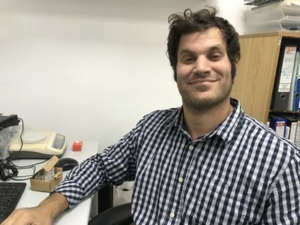Meet the Team Mondays: Daniel Shani

Daniel analyzes ancient dice using a magnifying glass, and reads various texts for our upcoming research.
Daniel Shani is one of the full time staff members here at the Temple Mount Sifting Site, and can usually be found in the lab conducting research, and occasionally giving tours on-site. Daniel was raised in the town of Maale Adumim, but currently lives with his wife and four children in a tranquil town in the Judaean desert. Daniel started his time with the TMSP on January 2006, with an interesting story. Daniel had read about the Sifting Project in a journal article in the early years of the project, and hoped to volunteer for a day, but never ended up getting around to it. Two years later, while Daniel was taking courses to become a licensed tour guide, Dr. Gabriel Barkay was a visiting scholar who lectured in his course for several days, and suggested to Daniel to volunteer at the site. His day of volunteering budded into a passion for archaeology, and Daniel joined the team. It was the TMSP which inspired Daniel to start a degree in archaeology at Bar-Ilan University, and make archaeology into his career.
Daniel is particularly interested in ancient game pieces, which he currently conducts research on in our laboratory. One of the most interesting finds has been the so-called cheater’s dice, which has inspired debate about whether or not the dice was truly used for cheating at all. Daniel believes that while there is a chance that this die (which only has sides with the numbers two, four, and six) may have been a cheaters  die, that it is significantly more likely that this was just a game with a different set of rules then many of our modern-day games which have dice numbered one through six. Daniel explained that there were an array of different dice in this period much like today, with some having exclusively even or odd numbers, and some having over twenty sides. Dice originate from Asia and the Middle East, and subsequently made their way through Europe, becoming a fixture of game culture in almost all civilizations. “In my opinion, it’s just too obvious to be cheater’s dice,”said Daniel, “And while it’s a more prosaic, and less exciting explanation, I think it simply belongs to a game of different rules.” In addition to these dice, one of the largest collections from an archaeological project in Israel, Daniel studies an array of different game pieces such as fragments of etched game boards, astralagus “Knuckle-bones” game pieces, and marveled glass pieces from the
die, that it is significantly more likely that this was just a game with a different set of rules then many of our modern-day games which have dice numbered one through six. Daniel explained that there were an array of different dice in this period much like today, with some having exclusively even or odd numbers, and some having over twenty sides. Dice originate from Asia and the Middle East, and subsequently made their way through Europe, becoming a fixture of game culture in almost all civilizations. “In my opinion, it’s just too obvious to be cheater’s dice,”said Daniel, “And while it’s a more prosaic, and less exciting explanation, I think it simply belongs to a game of different rules.” In addition to these dice, one of the largest collections from an archaeological project in Israel, Daniel studies an array of different game pieces such as fragments of etched game boards, astralagus “Knuckle-bones” game pieces, and marveled glass pieces from the

A close-up image of an ancient die, showing how delicate and small these items were.
later Muslim periods, to name a few examples.
In terms of what Daniel finds to be his source of motivation and drive to pursue archaeology, and believe in the importance of the TMSP’s mission, he cites the quote by Yigal Adin “A nation who doesn’t know it’s past will have an un-enriched present, and a shadowy future.” The drive to preserve and uncover the secrets of the most important archaeological site in Jerusalem is enough to keep Daniel passionate. In addition to working at the TMSP, Daniel is a licensed tour guide, with a certificate from Lander College for Men in Israel, and is one of the foremost experts on the history of the Mount of Olives cemetery. In addition to this, Daniel is a semi-professional hazzan (or Jewish liturgical cantor), and takes joy in learning the various songs and tunes which fill the halls of the synagogue.
Discover more from The Temple Mount Sifting Project
Subscribe to get the latest posts sent to your email.






Leave a Reply
Want to join the discussion?Feel free to contribute!